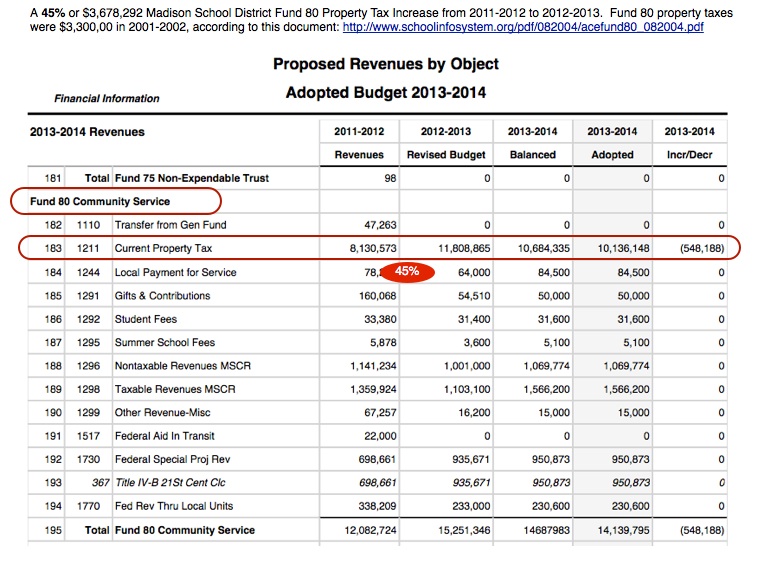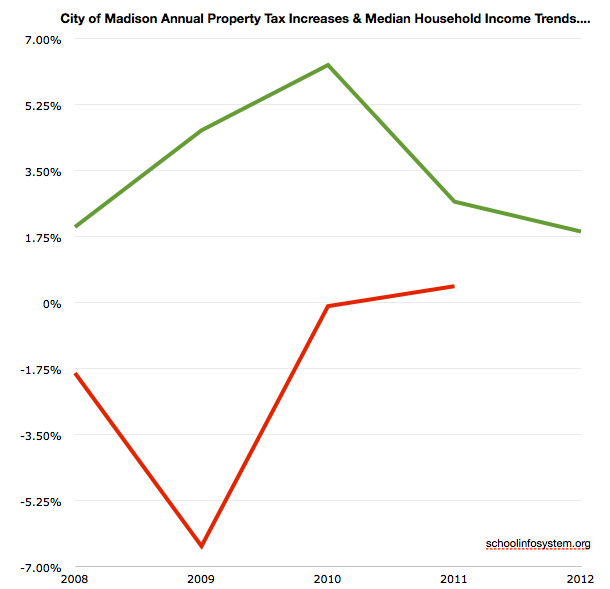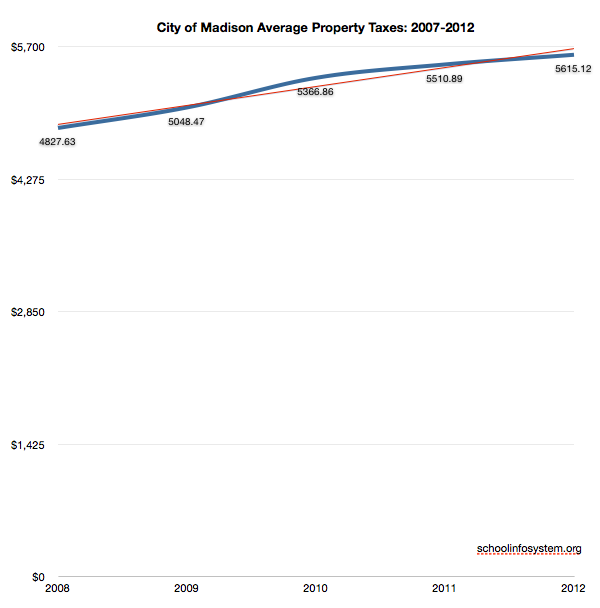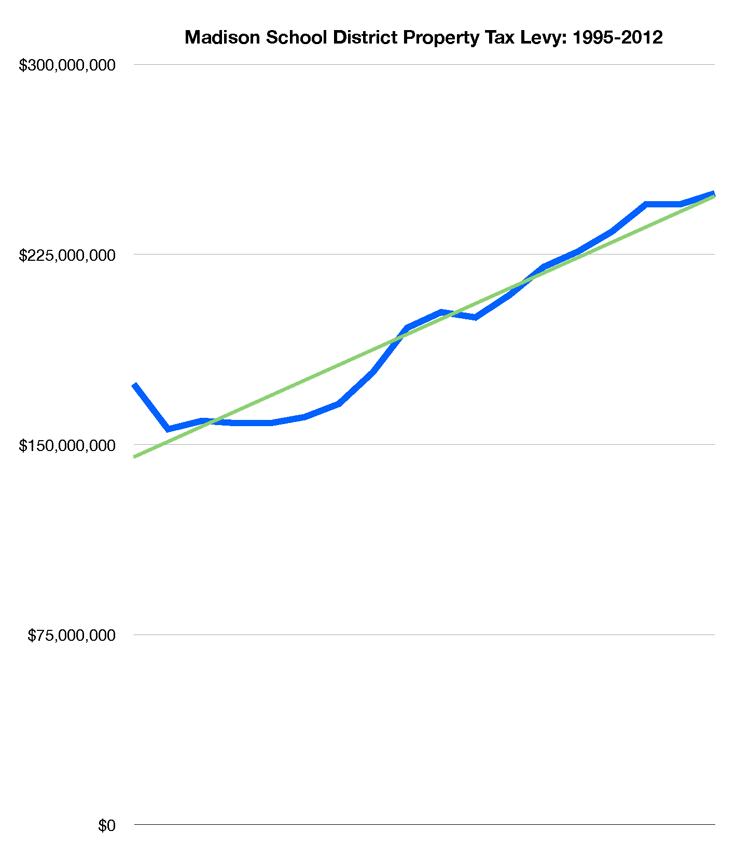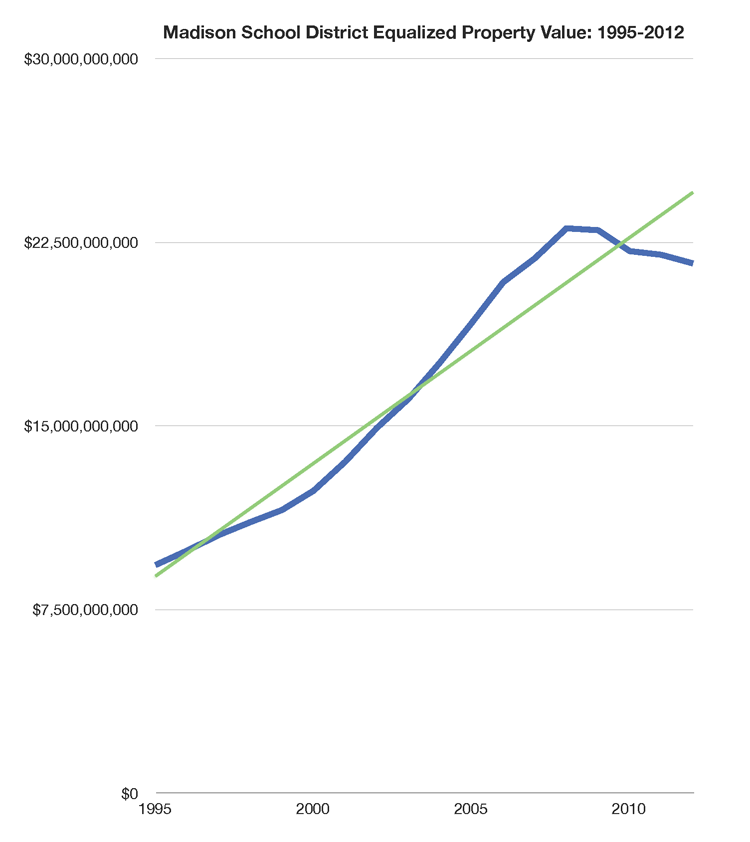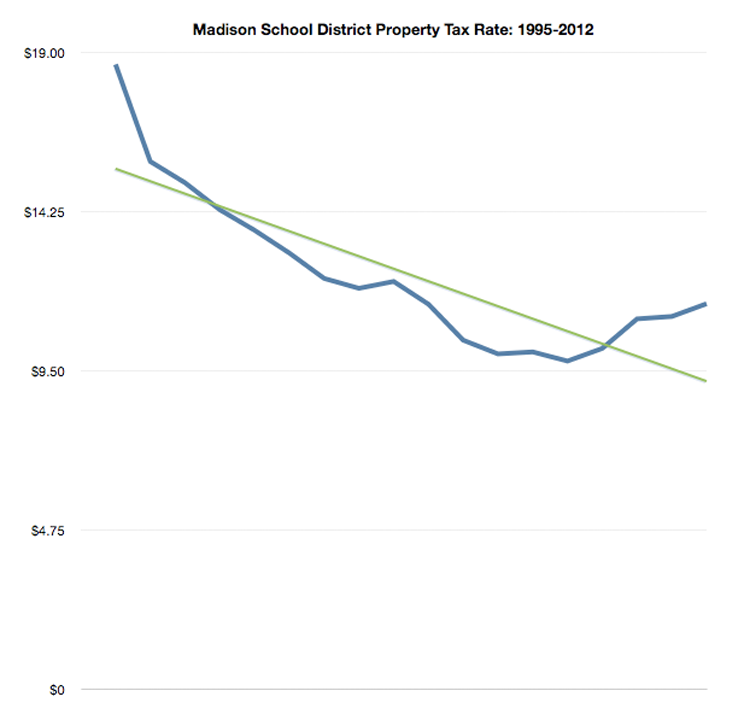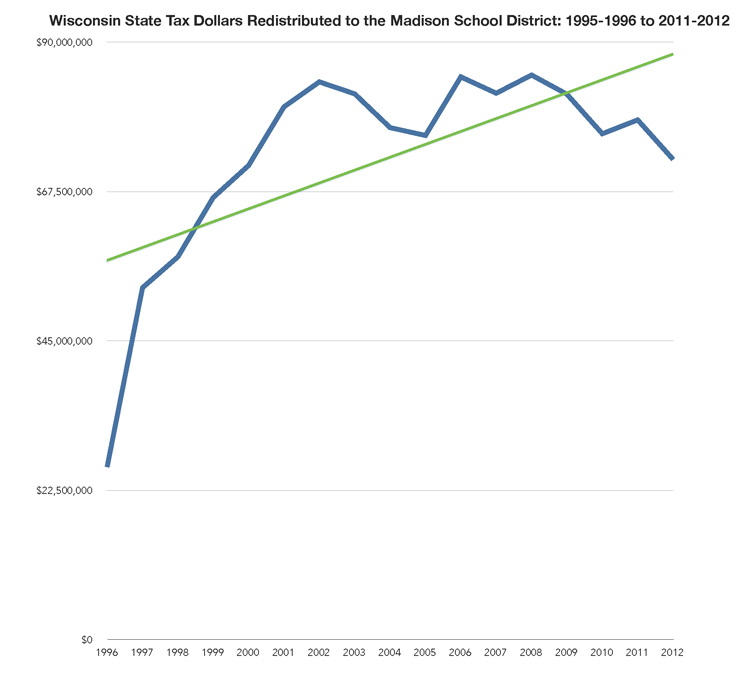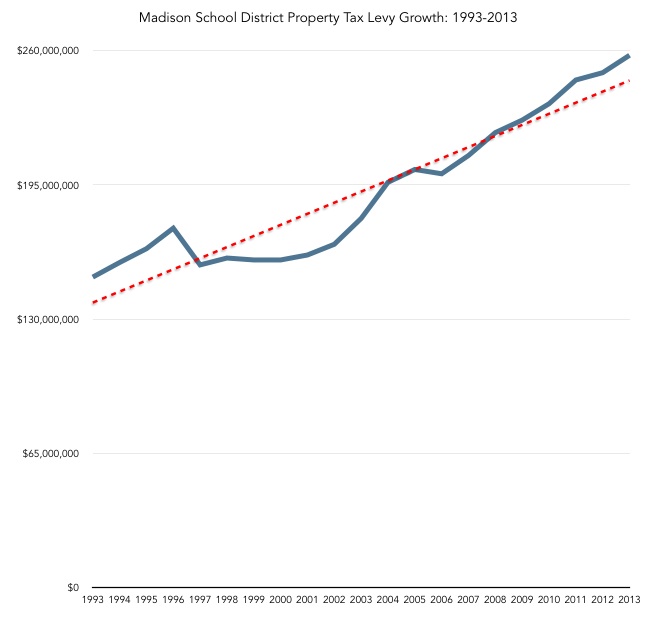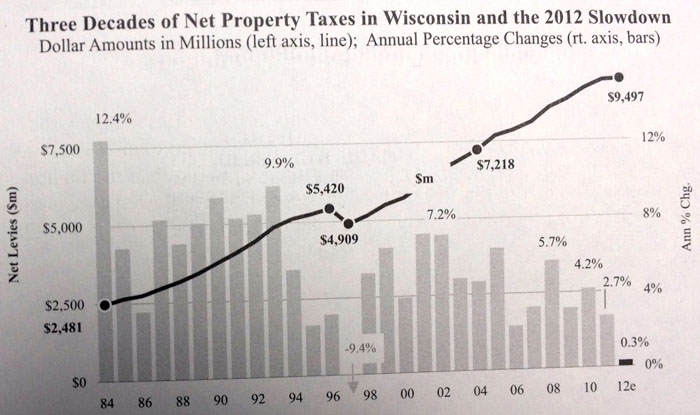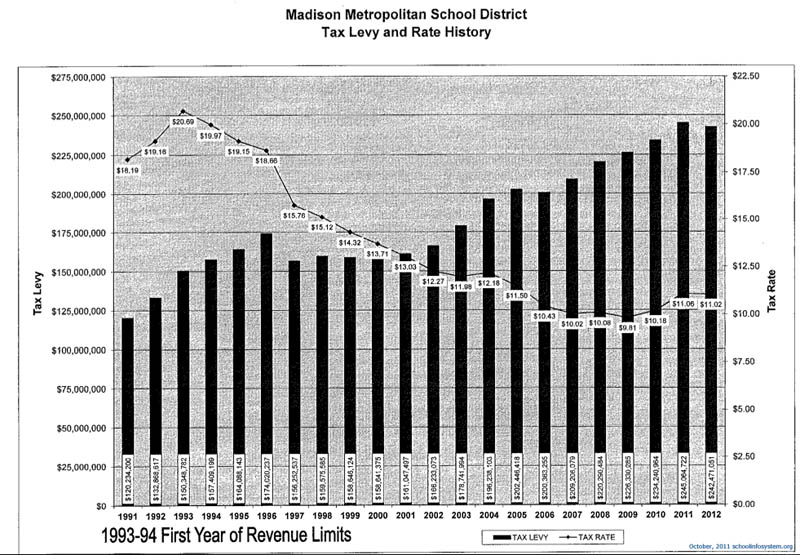Search Results for: "FUnd 80"
Instead of cutting taxes this year the Milwaukee Board of School Directors voted to increase its Fund 80 levy by $77.7 million.
Corrinne Hess: Fund 80 is a special fund for non-classroom activities that serve the entire community including adult education, recreation and day care services. By increasing the fund, the district’s total tax levy is $320 million this year. MPS officials told the Policy Forum that over $40 million of the Fund 80 increase will be […]
Using Wisconsin Fund 80 for Child Care
Raising Wisconsin: More than 50% of Wisconsinites, including 70% of rural residents, live in a child care “desert,” where there is only one licensed available child care slot for three or more children under age 5. In response, communities are using innovative approaches to address their child care needs, including the use of a taxing […]
45% (!) Increase in Madison Schools’ Fund 80 Property Taxes from the 2011-2012 to 2012-2013 School Year; No Mention of Total Spending
July, 2013 Madison Schools 2013-2014 Budget Presentation (PDF). Notes:
- No mention of total spending…. How might the Board exercise its oversight obligation without the entire picture?
- The substantial increase in redistributed state tax dollars (due to 4K) last year is not mentioned. Rather, a bit of rhetoric: “The 2013-14 budget development process has focused on actions which begin to align MMSD resources with the Strategic Framework Priorities and strategies to manage the tax levy in light of a significant loss of state aid.” In fact, according to page 6, the District expects to receive $46,392,012 in redistributed state tax dollars, which is a six (6%) increase over the funds received two years ago.
- The District’s fund equity (financial cushion, or reserves) has more than doubled in the past eight years, from $22,368,031 in 2005 to $46,943,263 in 2012.
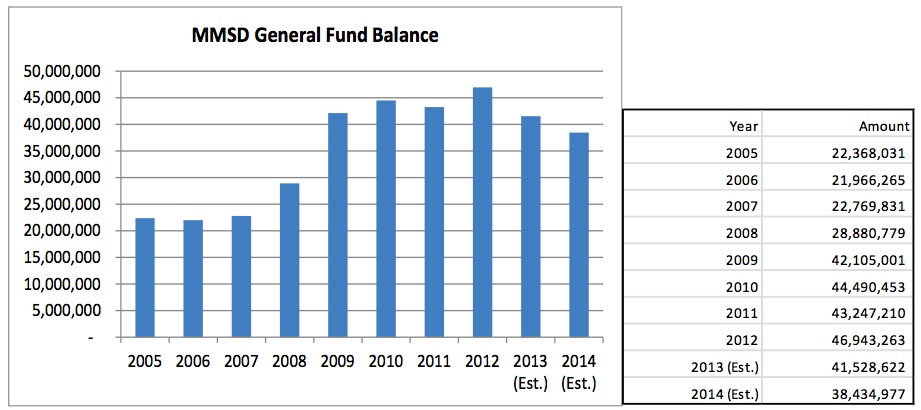
- Outbound open enrollment continues to grow, up 14% to 1,041 leavers in 2013 (281 inbound from other Districts).
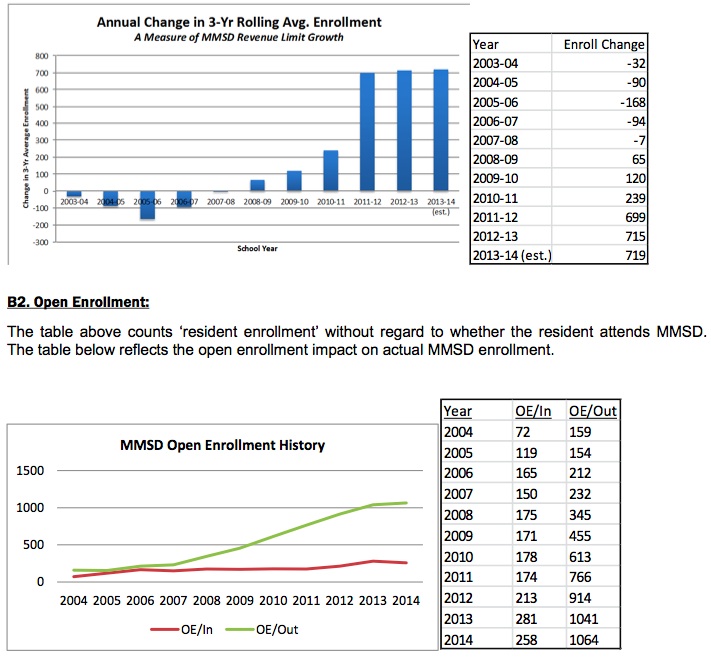
- There is no mention of the local tax or economic base:

- The growth in Fund 80 (MSCR) property taxes and spending has been controversial over the years. Fund 80, up until recently was NOT subject to state imposed property tax growth limitations.
- Matthew DeFour briefly summarizes the partial budget information here. DeFour mentions (no source referenced or linked – in 2013?) that the total 2013-2014 budget will be $391,000,000. I don’t believe it:
The January, 2012 budget document mentioned “District spending remains largely flat at $369,394,753” (2012-2013), yet the “baseline” for 2013-2014 mentions planned spending of $392,807,993 “a decrease of $70,235 or (0.02%) less than the 2012-13 Revised Budget” (around $15k/student). The District’s budget generally increases throughout the school year, growing 6.3% from January, 2012 to April, 2013. Follow the District’s budget changes for the past year, here.
Finally, the document includes this brief paragraph:
Work will begin on the 2014-15 early this fall. The process will be zero-based, and every line item and FTE will be carefully reviewed to ensure that resources are being used efficiently. The budget development process will also include a review of benefit programs and procurement practices, among other areas.
One hopes that programs will indeed be reviewed and efforts focused on the most urgent issues, particularly the District’s disastrous reading scores.
Ironically, the recent “expert review” found that Analysis: Madison School District has resources to close achievement gap. If this is the case (and I agree with their conclusion – making changes will be extraordinarily difficult), what are students, taxpayers and citizens getting for the annual tax & spending growth?
I took a quick look at property taxes in Middleton and Madison on a $230,000 home. A Middleton home paid $4,648.16 in 2012 while a Madison home paid 16% more, or $5,408.38.
Wisconsin Leglislative Fiscal Bureau Budget Memo on Fund 80 and School Related Changes
Bob Lang, Wisconsin Legislative Fiscal Bureau (PDF):
COMMUNITY SERVICE LEVY (FUND 80)
Prohibit a district from levying more for community service activities in 2013-14 and 2014- 15 than it did in the most recent year preceding 2013-14 in which the district levied for those activities. Provide that if a district wishes to exceed the limit on the community service levy, the school board could adopt a resolution to exceed the limit by a specified amount and submit the resolution to the electors of the district for approval. Specify that the limit otherwise applicable to the district would be increased by the amount approved by a majority of those voting on the question.
Under ASA 1, a school district would be prohibited from levying more for community service activities in 2013-14 and 2014-15 than it did in 2012-13.
3. PARENTAL CHOICE PROGRAMS — STUDENT PRIORITY
Specify that under the ~xpandedchoice program outside of Milwaukee and Racine, a private school would be required to give preference to a pupil who satisfies either of the following: (a) the pupil was enrolled in a public school in the school district in the previous year and is applying to attend the school in grades 2 through 8 or 10 through 12; or (b) the pupil was not enrolled in school in the previous school year.
Under current law, choice schools must select pupils on a random basis, except that they may give preference in accepting applications to siblings of pupils selected on a random basis. Under ASA 1, schools would be allowed to give preference in accepting applications to any of the following: (a) pupils who attended the school under the choice program during the school year prior to the school year for which the application is being made; (b) siblings of pupils who attended the school during the school year prior to the school year for which the application is being made and to siblings of pupils who have been accepted to the school for the school year for which the application is being made; and (c) pupils who attended another school under a parental choice program during the school year prior to the school year for which the application is being made.
PARENTAL CHOICE PROGRAMS — RELEASE OF INFORMATION
Require DPI, when publicly releasing data related to, but not limited to, enrollment of, standardized test results for, applications submitted by, waiting lists for, and other information related to pupils participating in or seeking to participate in parental choice programs, to release the data all at the same time, uniformly, and completely. Provide that DPI may selectively release portions of the information specified above only to the following: (a) the school district or an individual school; and (b) an entity requesting the information for a specific participating school or the school district, provided that the entity is authorized to obtain official data releases for that school or the school district.
5. PARENTAL CHOICE PROGRAMS — REQUIRED CREDENTIALS FOR TEACHERS
Modify current law that specifies that a teacher in a choice school have a bachelor’s degree, to also allow a degree or educational credential higher than a bachelor’s degree, including a masters or doctorate.
Madison School District Fund 80 Community Organization Spending Report
Superintendent Dan Nerad 1.9MB PDF:
Attached is the report summarizing progress after the first year from the community organizations receiving funding from the Madison Metropolitan School District. Also attached are the full end-of-year status reports from each organization, except the Urban League; their report will be provided in August. MMSD funding is now ended for . / African-American Ethnic Academy, Inc. . / Kajsiab House ./ Urban League of Greater Madison: Project Bootstrap 21st Century Careers Program
Funding, at this point, will continue for one more year for the other nine community organizations.“Fund 80” taxes (and spending) may increase beyond State of Wisconsin school district limits. Fund 80 spending growth has long been a source of controversy.
Madison School Board Discussion of Fund 80 Based Community Partnerships
Monday evening’s Madison School Board meeting included a fascinating and quite useful discussion of the way in which the district “grants” money to (or creates partnerships with) local groups via Fund 80 (Fund 80, or “Community Services” is money sourced from local property taxes that lives outside the state revenue caps. This means that Fund […]
Madison’s Fund 80 & Elections
TJ Mertz: In this morning’s Wisconsin State Journal there is a story that again misrepresents the place of Madison School Community Recreation and Fund 80 in the district and the community. The chart comparing Fund 80 levies in Madison to those in other districts ignores the fact that most or all of those locales have […]
Fund 80 Is Worth Our Support
Carol Carstensen: What is Fund 80, and why are people saying such awful things aboutit? Fund 80 is the state accounting code for community services expenditures,the major portion of which is for Madison SchoolCarstensen Community Recreation (MSCR) and the district’s cable channel 10.The current budget for community services is $11 million. Of that $8 millionis […]
Community Service Fund 80 — Can We Talk?
For full copies of this paper, including charts and citations, go to (html version): http:// www.votemathiak.com/Fund%2080-Mathiak.pdf http:// www.votemathiak.com/Fund%2080.doc A few weeks ago, Madison school board member Johnny Winston Jr. circulated a message that urged readers to support community organizations that had submitted grant proposals for funding under the district’s Community Service Fund (Fund 80). His […]
Proposals seeking money from MMSD Fund 80
Assistant Superintendent Roger Price provided the following electronic copies of the proposals the Board of Education will for funding on March 6: Kajsiab House and Freedom Inc. Gay, Lesbian, and Straight Education Network-South Central Wisconsin (GLSEN) Wisconsin Center for Academically Talented Youth (WCATY) The Charles Hamilton Houston Institute, Inc. (CHHI) Johnny Winston, Jr. explains the […]
Madison Schools: New Fund 80 Based Rec Sports Program
The Madison School Board approved (6-1) additional spending using Fund 80 (property taxes not subject to state revenue caps, in other words, local taxes that can go up as fast as the District approves) to create new rec sports programs: Sandy Cullen: Ruth Robarts, the only board member to vote against the spending increase, expressed […]
ACE Fund 80 White Paper
Don Severson forwarded the most recent Active Citizens for Education White Paper on the MMSD’s Community Service Fund (Fund 80) [64K PDF]: The Community Service Fund is used as an administrative and accountingmechanism for activities such as adult education; community recreation programs, such as evening swimming pool operation and softball leagues; elderly food service programs,non-special […]
ACE White Paper: Fund 80 & After School
Don Severson forwarded this Active Citizens for Education white paper on Fund 80 [272K PDF] and related after school changes. This site has a number of posts on the after school changes (essentially: replacing community after school partnerships with taxpayer funded MSCR programs via Fund 80. Fund 80, unlike other school expenditures is not limited […]
Taxpayer advocates seek School Fund 80 Audit
Don Severson forwarded this message recentlyTaxpayer advocates will hold a news conference Friday, August 27th at 1:00 p.m. at the Sequoia Library, 513 South Midvale Boulevard (Midvale Plaza) to call for an audit of �Community Services Fund 80� of the Madison School District. Don Severson, president of the Active Citizens for Education (ACE), will ask […]
FAQ: “Community Service” Funds aka “Fund 80”
Q: What is ?Fund 80?? A: A property tax that school districts may levy for ?community programs and services.? Unlike property tax levies for school operations, Fund 80 property taxes are subject to less restrictive revenue limits. Beginning in 1993, Wisconsin law has imposed limits on the increases in residential property taxes that school districts […]
Why, for example, were board members approving staff contracts they’d never seen? Why was the district administrator’s salary higher than his contract stipulated?
Annysa Johnson: One way to make enemies in a small-town school district, it turns out, is to start sniffing around its finances. Christa Reinert was hardly welcomed when she joined the Mercer School Board in 2016. She’d run, at least partly, in protest after two girls basketball coaches — one a sitting School Board member […]
Madison Schools’ 2014-2015 $402,464,374 Budget Document (April, 2014 version)
The Madison School District (3MB PDF): Five Priority Areas (just like the “Big 10”) but who is counting! – page 6: – Common Core – Behavior Education Plan – Recruitment and hiring – New educator induction – Educator Effectiveness – Student, parent and staff surveys – Technology plan 2014-2015 “budget package” 3MB PDF features some […]
Latest Madison Schools’ 2013-2014 $391,834,829 Budget
The Board of Education must adopt a tax levy by November 6, 2013. We recommend a total tax levy for all Funds of $257,727,292. This is a 3.38% increase over the prior year, and a 1.09% decrease over the levy estimate included in the August 2013 preliminary budget. The Board’s ‘unused’ levy authority, which can be preserved and carried forward, is $8.9 million.
We also recommend that the Board adopt a Fall Budget for 2013-14 which will replace the preliminary budget approved in August. The Fall Budget has been updated to reflect the latest information regarding funding, grants, and actual staffing levels. A review of all budget line items was included in the update process, with adjustments made wherever necessary to improve the accuracy of the budget.
The materials included in this packet provide multiple layers of detail concerning the budget and tax levy, from the concise ‘DP! recommended budget format’ to more detailed views of the budget and levy.The current 2013-2014 budget spends $391,834,829 for 27,186 pk-12 students or $14,413/student. Note that per student spending is not linear for pre-k plus full time students.
Related: Madison’s Planned $pending & Property Tax Increase: Does it Include $75/Student “Unrestricted” State Budget Increase (Outside of Revenue Caps)?, 45% (!) Increase in Madison Schools’ Fund 80 Property Taxes from the 2011-2012 to 2012-2013 School Year; No Mention of Total Spending, Madison Schools’ 2013-2014 Budget Charts, Documents, Links, Background & Missing Numbers and Madison’s disastrous reading results.
Madison’s Proposed Property Tax Increase: Additional links, notes and emails
I received a kind email from Madison School Board President Ed Hughes earlier today regarding the proposed property tax increase associated with the 2013-2014 District budget.
Ed’s email:Jim —
Your comparison to the tax rates in Middleton is a bit misleading. The Middleton-Cross Plains school district that has a mill rate that is among the lowest in Dane County. I am attaching a table (.xls file) that shows the mill rates for the Dane County school districts. As you will see, Madison’s mill rate is lower than the county average, though higher than Middleton’s. (Middleton has property value/student that is about 10% higher than Madison, which helps explain the difference.)
The table also includes the expenses/student figures relied upon by DPI for purposes of calculating general state aid for the 2012-13 school year. You may be surprised to see that Madison’s per-student expenditures as measured for these purposes is among the lowest in Dane County. Madison’s cost/student expenditures went up in the recently-completed school year, for reasons I explain here: http://tinyurl.com/obd2wty
EdMy followup email:
Hi Ed:
Thanks so much for taking the time to write and sending this along – including your helpful post.
I appreciate and will post this information.
That said, and as you surely know, “mill rate” is just one part of the tax & spending equation:
1. District spending growth driven by new programs, compensation & step increases, infinite campus, student population changes, open enrollment out/in,
2. ongoing “same service” governance, including Fund 80,
3. property tax base changes (see the great recession),
4. exempt properties (an issue in Madison) and
5. growth in other property taxes such as city, county and tech schools.
Homeowners see their “total” property taxes increasing annually, despite declining to flat income. Middleton’s 16% positive delta is material and not simply related to the “mill rate”.
Further, I continue to be surprised that the budget documents fail to include total spending. How are you evaluating this on a piecemeal basis without the topline number? – a number that seems to change every time a new document is discussed.
Finally, I would not be quite as concerned with the ongoing budget spaghetti if Madison’s spending were more typical for many districts along with improved reading results. We seem to be continuing the “same service” approach of spending more than most and delivering sub-par academic results for many students. (Note the recent expert review of the Madison schools Analysis: Madison School District has resources to close achievement gap.)
That is the issue for our community.
Best wishes,
Jim
Related: Middleton-Cross Plains’ $91,025,771 2012-2013 approved budget (1.1mb PDF) for 6,577 students, or $13,840.01 per student, roughly 4.7% less than Madison’s 2012-2013 spending.
Positioning The Madison School District’s 2012-2013 Budget
Madison School District officials hope to avoid layoffs and spare employees from contributing to their health insurance premiums next school year, though to do so they might have to raise property taxes.
Superintendent Dan Nerad won’t make his preliminary budget recommendations until April 1, but in its first look at the 2012-13 school budget, the district is projecting a $12.4 million deficit based on current budget trends.
Factoring in rising insurance and fuel costs, the district projects general fund spending of $319.7 million, up from $310.9 million this year. Revenues are projected to be $307.3 million.
The district is looking at several options to close the gap, such as eliminating its most expensive health insurance option, renegotiating nonunion employee contracts, energy efficiency projects, refinancing debt and raising property taxes, said Erik Kass, assistant superintendent for business services.
“The hope is we won’t have to take more out of employee pockets or do any layoffs,” Kass said.Unfortunately, DeFour’s article does not include the District’s total proposed spending, rather it mentions just one portion. It would be better to not mention such incomplete numbers, rather than further muddying the often challenging budget “transparency”. The District will spend roughly $370,000,000 +/- a few million in 2011-2012:
2011-2012 Revised Budget 1.3MB PDF (Budget amendments document). District spending remains largely flat at $369,394,753, yet “Fund Equity”, or the District’s reserves, has increased to $48,324,862 from $22,769,831 in 2007 (page 24). The District’s property tax “underlevy” (increases allowed under Wisconsin school revenue limits which are based on student population changes, successful referendums along with carve-outs such as Fund 80, among others) will be $13,084,310. It also appears that property taxes will be flat (page 19) after a significant 9% increase last year. Interestingly, MSCR spending is up 7.97% (page 28).
2011-2012 enrollment is 24,861. $369,394,753 planned expenditures results in per student spending of $14,858.40.
Should the MPS Levy Solely Fund the Education of MPS Students?
John Gurda wrote this weekend on the Socialist roots of the Milwaukee Public School’s (MPS) Department of Recreation and Community Services. The department offers sports programs, community education, and various other activities for the Milwaukee community. Gurda argues, and I agree, that Milwaukee Recreation is an asset to the city and its residents. The question I have is should it be part of MPS?
I do not question the ability of MPS to run the department, just the rationale for having a program not directly related to the education of MPS students housed in the school district. Maybe the task of providing recreational opportunities for residents of Milwaukee would be better placed at the City or County.
Perhaps more important, Milwaukee Recreation is funded through MPS; 4.4% of the 2011 MPS tax levy ($13.3 million) was for this department. This raises a broader question, should the MPS tax levy be used to raise funds for anything beyond educating MPS pupils?
In 2011, only about 80% ($244,262,102) of the MPS levy went towards regular district operations.Related: Madison’s Fund 80.
2011-2012 $369,394,753 Madison Schools Budget update
2011-2012 Revised Budget 1.3MB PDF (Budget amendments document). District spending remains largely flat at $369,394,753, yet “Fund Equity“, or the District’s reserves, has increased to $48,324,862 from $22,769,831 in 2007 (page 24). The District’s property tax “underlevy” (increases allowed under Wisconsin school revenue limits which are based on student population changes, successful referendums along with carve-outs such as Fund 80, among others) will be $13,084,310. It also appears that property taxes will be flat (page 19) after a significant 9% increase last year. Interestingly, MSCR spending is up 7.97% (page 28).
2011-2012 enrollment is 24,861. $369,394,753 planned expenditures results in per student spending of $14,858.40.
I welcome clarifications and updates to these numbers, which are interesting. We’ve seen a doubling of District reserves over the past few years while spending has remained relatively flat as has enrollment.
Finally, this is worth reading in light of the District’s 2011-2012 numbers: Madison Superintendent Dan Nerad Advocates Additional Federal Tax Dollar Spending & Borrowing via President Obama’s Proposed Jobs Bill.
Wisconsin School Property Tax Levies Set for 2009-10 Tax Bill, Up 6.0%
School property tax levies for 2009-10 are up 6.0%, from $4.28 billion last year to $4.54 billion this year, according to the Wisconsin Taxpayers Alliance (WISTAX), a nonprofit, nonpartisan research organization. The rise in school taxes exceeded last year’s increase of 5.2%, due principally to state budget cuts in aid to K-12 schools.
According to WISTAX, tax changes ranged from increases of 41.2% in Seneca and 32.8% in Gilmanton to reductions of more than 19% in Ladysmith and Sharon J1. However, increases larger than those in prior years were the norm, and 116 districts (27%) of the state’s 425 districts had increases of 10% or more. In another 151 districts, levies were up between 5% and 10%. Only 42 districts cut property taxes.
“Although state budget reductions and tighter school revenue limits have made the headlines,” noted WISTAX President Todd A. Berry, “the more telling stories are coming from budget details.”
For example, schools raised their general fund levies more than 8%, well above the overall 6% increase. They pared back the overall increases by retiring or refinancing debt and by rearranging expenditures formerly charged to a little-known fund exempt from state revenue limits: fund 80, or the community services fund. This fall, 78 of 425 districts trimmed community service levies that fund such items as community recreation and adult classes; 10 districts eliminated the tax altogether. These actions served to reduce what would otherwise have been an 8.2% tax increase.
The Madison School District = General Motors?
A provocative headline.
Last Wednesday, Ripon Superintendent Richard Zimman spoke to the Madison Rotary Club on “What Wisconsin’s Public Education Model Needs to Learn from General Motors Before it is too late.” 7MB mp3 audio (the audio quality is not great, but you can hear the talk if you turn up the volume!).
Zimman’s talk ranged far and wide. He discussed Wisconsin’s K-12 funding formula (it is important to remember that school spending increases annually (from 1987 to 2005, spending grew by 5.10% annually in Wisconsin and 5.25% in the Madison School District), though perhaps not in areas some would prefer.
“Beware of legacy practices (most of what we do every day is the maintenance of the status quo), @12:40 minutes into the talk – the very public institutions intended for student learning has become focused instead on adult employment. I say that as an employee. Adult practices and attitudes have become embedded in organizational culture governed by strict regulations and union contracts that dictate most of what occurs inside schools today. Any impetus to change direction or structure is met with swift and stiff resistance. It’s as if we are stuck in a time warp keeping a 19th century school model on life support in an attempt to meet 21st century demands.” Zimman went on to discuss the Wisconsin DPI’s vigorous enforcement of teacher licensing practices and provided some unfortunate math & science teacher examples (including the “impossibility” of meeting the demand for such teachers (about 14 minutes)). He further cited exploding teacher salary, benefit and retiree costs eating instructional dollars (“Similar to GM”; “worry” about the children given this situation).
Zimman noted that the most recent State of Wisconsin Budget removed the requirement that arbitrators take into consideration revenue limits (a district’s financial condition @17:30) when considering a District’s ability to afford union negotiated compensation packages. The budget also added the amount of teacher preparation time to the list of items that must be negotiated….. “we need to breakthrough the concept that public schools are an expense, not an investment” and at the same time, we must stop looking at schools as a place for adults to work and start treating schools as a place for children to learn.”
In light of this talk, It has been fascinating to watch (and participate in) the intersection of:
- our local School District’s Strategic Planning Process, and
- Governance, via our elected School Board, and
- Dan Nerad and Erik Kass, our somewhat new Superintendent and Director of Business Services, and
- the Administration, and local organizations that receive funding via our school system (“Fund 80“, among others)
Several years ago, former Madison Superintendent Art Rainwater remarked that “sometimes I think we have 25,000 school districts, one for each child”.
I found Monday evening’s school board meeting interesting, and perhaps indicative of the issues Zimman noted recently. Our public schools have an always challenging task of trying to support the growing range of wants, needs and desires for our 24,180 students, staff members, teachers, administrators, taxpayers and parents. Monday’s topics included:
- The possible hiring of 44 full time employees along with 7 figure “professional development expenditures” via federal tax receipts and borrowed funds (funded for only two years, which means cuts, tax increases or both at that time), and
- property tax implications of the District’s $12M current deficit [public comment on the budget in this 8MB mp3 audio file], and
- a rather amazing discussion of the District’s implementation of “standards based middle school report cards (think of the cost!) [30MB mp3 audio file], and
- the proposed Talented and Gifted Plan (with an interesting discussion on how many TAG staff members have training in this area vs those who work in other areas such as special education [45MB mp3 audio file]), and two, seamingly small items on the agenda that identify future initiatives (or, in the case of elementary math, continuing the “reform” model that has been in place for some time):
- District wide dual immersion proposal, including all four high schools, and
- Elementary math curriculum purchases.
I’ve not mentioned the potential addition of 4K, high school redesign or other topics that bubble up from time to time.
In my layperson’s view, taking Zimman’s talk to heart, our public schools should dramatically shrink their primary goals and focus on only the most essential topics (student achievement?). In Madison’s case, get out of the curriculum creation business and embrace online learning opportunities for those students who can excel in that space while devoting staff to the kids who need them most. I would also like to see more opportunities for our students at MATC, the UW, Edgewood College and other nearby institutions. Bellevue (WA) College has a “running start” program for the local high school.
Chart via Whitney Tilson.
Richard Zimman closed his talk with these words (@27 minutes): “Simply throwing more money at schools to continue as they are now is not the answer. We cannot afford more of the same with just a bigger price tag”.
General Motors as formerly constituted is dead. What remains is a much smaller organization beholden to Washington. We’ll see how that plays out. The Madison School District enjoys significant financial, community and parental assets. I hope the Administration does just a few things well.
WIBA’s Mitch Henck Discusses the Madison School District’s Budget with Don Severson
24MB mp3 audio file. Mitch and Don discuss the Madison School District’s $12M budget deficit, caused by a decline in redistributed tax dollars from the State of Wisconsin and generally flat enrollment. Topics include: Fund 80, health care costs, four year old kindergarten, staffing, property taxes (which may increase to make up for the reduced state tax dollar funding).
Madison School District Board President Arlene Silveira sent this message to local Alders Saturday:Good afternoon,
Below is an update of the MMSD budget situation.
As you know, the biennial budget was signed into law at the end of June. The budget had numerous provisions that will effect the future of public education that include:
- Repeal of the Qualified Economic Offer (QEO)
- Decrease in funding for public education by the state of approximately $14720million
- Decrease in the per pupil increase associated with revenue limits
The repeal of the QEO will potentially impact future settlements for salries and benefits. The decrease in funding for public education by the state creates the need for a tax increase conversation in order to sustain current programs. The decrease in the revenue limit formula will cause MMSD to face more reductions in programs and services for the next 2 years at a minimum.
EFFECT OF STATE BUDGET ON MMSD
- Decrease in state aid: $9.2 million
- Reduction in revenue: $2.8 million (decrease in the per pupil increase from $275 to $200/pupil)
Total decrease: projected to to be $12 million
Last May, the Madison Board of Education passed a preliminary 2009-10 budget that maintained programs and services with a modest property tax increase. The groundwork for our budget was laid last fall when the Board pledged our commitment to community partnership and the community responded by supporting a referendum that allowed us to exceed revenue caps to stabilize funding for our schools. Two months later, with programs and staff in place for next year, we find ourselves faced with State funding cuts far exceeding our worst fears.
HOW DID THIS HAPPEN?
We are in this position in part because Wisconsin’s school funding formulas are so complicated that the legislature and supporting agencies did not accurately predict the budget’s impact on school districts. State aid to Madison and many other districts was cut by 15%. In practical terms, coupled with additional State cuts of $2.8 million, MMSD is saddled with State budget reductions of $12 million this year.
This grim situation is a result of a poor economy, outdated information used by the legislature, and a Department of Public Instruction policy that penalizes the district for receiving one-time income (TIF closing in Madison). Federal stimulus funds will, at best, delay cuts for one year. We are left with a gaping budget deficit when many fiscal decisions for the upcoming school year cannot be reversed.
WHAT ARE WE GOING TO DO?
We are working on strategies and options and are looking carefully at the numbers to ensure our solutions do not create new problems. We will evaluate options for dealing with the budget in early August.
To repair our budget, we are working with legislators and the DPI to appeal decisions that have placed us in this position. We continue to look for changes in resource management to find additional cost reductions. We are seeking ways to offset the impact of school property tax increases if we need to increase our levy.
At the same time, we pledge that we will not pass the full cost of the cuts along as increased property taxes. We will not resort to massive layoffs of teachers and support staff, t he deadline having passed to legally reduce our staff under union contracts.
I will be back in touch after our August meeting when we have made decisions on our path forward.
If you have any questions, please do not hesitate to contact me.
Arlene Silveira
Madison Board of Education
608-516-8981Related: Sparks fly over Wisconsin Budget’s Labor Related Provisions.
Is the 2008 School Referendum Just More of the Same? No!
On November 4, the Madison School Board is asking voters to vote yes on a referendum that will increase the property tax support base for Madison’s public schools by a total of $13 million after three years. For owners of a $250,000, that translates to an additional $90 in property taxes by the third year. […]
Wisconsin State & School Finance Climate Update
I recently had an opportunity to visit with Todd Barry, President of the Wisconsin Taxpayers Alliance [29 minute mp3]. A summary of this timely conversation follows:
[2:25] Post Retirement Liabilities: Milwaukee Public Schools Post Retirement Health Care Liabilities: $2.2 to $2.5 billion
[3:01] Wisconsin’s $2.44 Billion structural deficit. The State debt load ($4billion to $9billion from 2000 to 2007) is now among the top 10.
[7:48] On property values and assessment changes. Two years ago, property values grew 9%, last year 6%, 3% this year with most of the recent growth coming from commercial properties.
[8:57] Wisconsin Income Growth: Per Capita personal income “The canary in the mineshaft” and how we lag the national average by 6% or more.
Why?
The population is aging. Senior population will double by 2030. School age population is stagnant.
Employment growth peaked before the nation (04/05)
Wisconsin wages per worker is about 10% less than the national average. 1969; 4% below national average, 1980’s; 10 or 11% below national average. Wisconsin wagers per worker are now 14% below national average. We’ve been on a 40 year slide.
We’ve hid this because the labor force participation of women has increased dramatically.
Wisconsin is losing corporate headquarters.
[18:18] What does this all mean for K-12 spending?
“If there is going to be growth in any state appropriation,it is going to be schools and Medicaid“. The way the Legislature and Governor have set up these two programs, they are more or less on auto-pilot. They will grab whatever money is available and crowd out most everything else. So you get this strange situation where state aid to schools has tripled in the last 25 years while funding for the UW has barely doubled. That sounds like a lot, but when you look at it on a year by year basis, that means state funding for the University of Wisconsin System has grown less than the rate of inflation on an annual average basis while school aids has outpaced it (inflation) as has Medicaid.”
Is there anything on the horizon in terms of changes in school finance sources? A discussion of shifting state school finance to the sales tax. “It’s clear that in states where state government became even more dominant (in K-12 finance) than in Wisconsin, the net result, in the long run, was a slowing of state support for schools. The legislature behaves like a school board, micromanaging and mandating. California is the poster child.
[20:52] On why the Madison School District, despite flat enrollment and revenue caps, has been able to grow revenues at an average of 5.25% over the past 20 years. Barry discussed: suburban growth around Madison, academic competition amongst Dane County high schools. He discussed Madison’s top end students (college bound kids, kids of professionals and faculty) versus the “other half that doesn’t take those (college entrance) tests” and that the “other half” is in the bottom 10 to 20% while the others are sitting up at the top on college entrance exams.
[23:17]: This is a long way of saying that Madison has made its problem worse and has put itself on a course toward flat enrollment because of social service policies, school boundary policies and so forth that have pushed people out of the city.
[23:42] “If there is a way within state law to get around revenue caps, Madison has been the poster child”. Mentions Fund 80 and frequent and successfully passing referendums along with Madison’s high spending per pupil.
People think of the Milwaukee Public Schools as a high spending District. When you really look start to dig into it, it is above average, but Madison is way out there compared to even MPS. People argue that argue that MPS is top heavy in terms of administrative costs per student, Madison actually spends more in some of those categories than Milwaukee. (See SchoolFacts, more)
[26:45] On K-12 School finance outlook: The last time we blew up the school finance system in Wisconsin was in 1994. And, it happened very quickly within a span of 2 to 3 months and it had everything to do with partisan political gotcha and it had nothing to do with education.
[28:26] “Where are the two bastians of Democratic seats in the legislature? Madison and Milwaukee. Madison is property rich and Milwaukee is relatively property poor. Somehow you have to reconcile those two within a Democratic environment and on the Republican side you have property rich suburbs and some very property poor rural districts.
A Public Hearing on Madison’s November, 2008 Referendum
Taxpayers got a chance to ask the questions Tuesday night about the upcoming multimillion dollar Madison school referendum.
More than a dozen people turned out to Sherman Middle School for the first of four public hearings across the city.
Superintendent Dan Nerad gave a brief presentation before opening the forum up for questions.
Voters questioned everything from Fund 80 to the Capital Expansion Fund and student achievement.
Active Citizens for Education said they would like to have seen the referendum scheduled for the spring in order to give the district time to re-evaluate programs that they say are not working – programs that could be cut or changed.
“Where they’re talking about maintaining current programs and services it’s not getting good results,” said ACE’s Don Severson. “You look at the achievement gap, look at increased truancy, look an an increased drop-out rate, decreased attendance rates, more money isn’t going to get different results.”
Referendum supporters, Communities And Schools Together, know the $13 million referendum will be a tough sell, but worth it.
“I think it is going to be a hard sell,” said CAST member and first-grade teacher Troy Dassler. “We really need to get people out there who are interested still in investing in infrastructure. I can think of no greater an investment — even in the most difficult tough times that we’re facing that we wouldn’t invest in the future of Madison.”School Board President Arlene Silveira was pleased with the dialogue and questions asked at the forum and said she hasn’t been overwhelmed with questions from constituents about the referendum.
“It’s been fairly quiet, and I think it’s been overshadowed by the presidential election and (downturn with) the economy,” Silveira said. “People are very interested, but it does take an explanation.
“People ask a lot of questions just because it’s different (with the tax components). Their initial reaction is: Tell me what this is again and what this means? They realize a lot of thought and work has gone into this and certainly this is something they will support or consider supporting after they go back and look at their own personal needs.”
Superintendent Dan Nerad has already formulated a plan for program and service cuts in the 2009-2010 budget if voters do not pass the referendum. Those include increasing class sizes at elementary and high schools, trimming services for at-risk students, reducing high school support staff, decreasing special education staffing, and eliminating some maintenance projects.
Nerad said outlining potential budget cuts by general categories as opposed to specific programs was the best route for the district at this juncture.
DCPAC Dan Nerad Meeting Summary
A video tape of the entire presentation and discussion with Dr. Nerad may be viewed by visiting this internet link: https://www.schoolinfosystem.org/archives/2008/09/ madison_superin_10.php
Dan Nerad opened his remarks by stating his commitment to efforts for always continuing change and improvement with the engagement of the community. He outlined four areas of focus on where we are going from here.
- Funding: must balance district needs and taxpayer needs. He mentioned the referendum to help keep current programs in place and it will not include “new” things.
- Strategic Plan: this initiative will formally begin in January 2009 and will involve a large community group process to develop as an ongoing activity.
- Meet people: going throughout the community to meet people on their own terms. He will carefully listen. He also has ideas.
- Teaching and learning mission: there are notable achievement gaps we need to face head-on. The “achievement gap” is serious. The broader mission not only includes workforce development but also helping students learn to be better people. We have a “tale of two school districts” – numbers of high achievers (including National Merit Scholars), but not doing well with a lot of other students. Low income and minority students are furtherest away from standards that must be met. Need to be more transparent with the journey to fix this problem and where we are not good. Must have the help of the community. The focus must be to improve learning for ALL kids, it is a “both/and” proposition with a need to reframe the issue to help all kids move forward from where they are. Must use best practices in contemporary assessment, curriculum, pedagogy and instructional methods.
Dr. Nerad discussed five areas about which he sees a need for community-wide conversations for how to meet needs in the district.
- Early learning opportunities: for pre-kindergarten children. A total community commitment is needed to prevent the ‘achievement gap’ from widening.
- High schools: How do we want high schools to be? Need to be more responsive. The curriculum needs to be more career oriented. Need to break down the ‘silos’ between high school, tech schools and colleges. Need to help students move through the opportunities differently. The Small Learning Communities Grant recently awarded to the district for high schools and with the help of the community will aid the processes for changes in the high schools.
- School safety: there must be an on-going commitment for changes. Nerad cited three areas for change:
a. A stronger curriculum helping people relate with other people, their differences and conflicts.
b. A response system to safety. Schools must be the safest of sanctuaries for living, learning and development.
c.Must make better use of research-based technology that makes sense.- Math curriculum and instruction: Cited the recent Math Task Force Report
a. Good news: several recommendations for curriculum, instruction and policies for change.
b. Bad news: our students take less math than other urban schools in the state; there are notable differences in the achievement gap.- Fine Arts: Cited recent Fine Arts Task Force Report. Fine arts curriculum and activities in the schools, once a strength, has been whittled away due to budget constraints. We must deal with the ‘hands of the clock’ going forward and develop a closer integration of the schools and community in this area.
Madison Superintendent Recommends Three Year Recurring Spending Increase via a November, 2008 Referendum
Nerad told school board members on Monday night that he’s recommending a three-year recurring referendum.
It’s part of what he called a partnership plan to address the budget shortfall.
The plan would put a referendum on the November ballot for $5 million and would ask voters for $4 million in the two following years.
Nerad said to make up the remaining $3 million gap the district would move $2 million from the district’s fund balance, eliminate $600,000 in unallocated staff, which are positions set aside in case of additional enrollment, and make up the remaining $400,000 through other reductions, which he has not yet named.
“We’re working both sides of this and in the end our kids need things from us, our taxpayers need us to be sensitive and all I can say is we tried every step of putting these recommendations together to be responsive on both fronts,” said Nerad.The measure, a “recurring referendum,” would give the district permission to build on the previous year’s spending limit increase by additional amounts of $4 million in 2010-11 and another $4 million in 2011-12. The measure would permit a total increase of $13 million — a change that would be permanent, unlike the impact of some other referendums that end after a specified period.
Approval of the referendum would cost the owner of a home with an assessed value of $250,000 an estimated $27.50 in additional taxes in the 2009-10 school year. That represents an increase of 1.1 percent of the School District’s portion of the tax bill.
But for at least the next two years, the schools’ portion of that homeowner’s tax bill would decline even if the referendum is approved, under the plan developed by Nerad and Erik Kass, assistant superintendent for business services.
They estimate the tax bill for 2010-11 would be $27.50 lower than it is now, and the bill the following year would be about $100 below its current level if voters back the referendum and the School Board implements proposed changes in accounting measures.In the first year, the referendum would add an additional $27.50 onto the tax bill of a $250,000 home. Another initiative in Nerad’s recommendation, drawn up along with Assistant Superintendent of Business Services Erik Kass, is to enact changes to help mitigate the tax impact of the referendum. Nerad and Kass said these changes would decrease taxes for homeowners in the second and third year of the referendum.
One aspect of the proposal would return $2 million of an equity to the taxpayers in the form of a reduced levy in the Community Services Fund (Fund 80) for the 2009-10 school year. The second part of the tax impact referendum would be implementation of a Capital Expansion Fund, called Fund 41, in an effort to levy a property tax under revenue limits to spread the costs of facility maintenance projects over a longer period.
Nerad said the referendum process has been a deliberative process, and he’s been cognizant of weighing board members and community questions.Links:
- Proposed 2008-2009 $367,806,712 budget
- 2007-2008 $339,685,844 Citizen’s Budget
- 2006-2007 $333,101,865 Citizen’s Budget
Links:
- Transcript: 7/28/2008 Madison School Board Referendum Discussion
- Don Severson: Memo to the Madison School Board on the District’s Financial Situation
- Capital Times Editorial advocating a November, 2008 referendum vote.
- Madison Cast: Supporting a referendum
- Wisconsin’s per student K-12 spending ranks 17th nationwide.
“No Surprises in School Budget, but Referendum Looms”
Facing a possible referendum and $9.2 million hole for the 2009-10 school year, no major alterations are anticipated to the school 2008-09 budget that will be finalized Monday by Madison School Board members.
When new superintendent Dan Nerad starts in July, referendum discussion will come to the forefront for the Madison Metropolitan School District. If Board members decide to propose a referendum, which could occur as early as November, they will request taxpayers consider overriding state-imposed revenue gaps so that services and programs won’t have to be severely slashed from the district’s budget.
In the meantime, only one administrative amendment and two Board amendments are on the agenda and approval is expected at the School Board meeting as superintendent Art Rainwater presents plans for the final budget of his tenure. Rainwater, who has worked with the district for 14 years — including the last 10 as superintendent — will retire this summer. Nerad will take over on July 1.
School Board members are well aware of the multi-million budget cuts looming for the 2009-10 school year, and Rainwater said he wasn’t surprised with short list of amendments.
“I think the overall intention for the Board from day one was really and truly to work to preserve exactly what we have,” Rainwater said during a telephone interview Friday.Notes and links on the proposed $367,806,712 2008/2009 budget.
Three proposed budget amendments:
- Limit Fund 80 spending to a 4% increase [19K PDF]
- Limit Fund 80 spending to a 4% increase [19K PDF]
- Increase technology purchases by $100,000 and reduced the reserve for contingency
- Limit Fund 80 spending to a 4% increase [9K PDF]
- Increase the Fund 80 tax levy by $60,000 for the Madison Family Literacy / Even Start Literacy Program [9K PDF]
Much more on Fund 80 here.
Media Education Coverage: An Oxymoron?
Lucy Mathiak’s recent comments regarding the lack of substantive local media education coverage inspired a Mitch Henck discussion (actually rant) [15MB mp3 audio file]. Henck notes that the fault lies with us, the (mostly non) voting public. Apathy certainly reigns. A useful example is Monday’s School Board’s 56 minute $367,806,712 2008/2009 budget discussion. The brief chat included these topics:
- Retiring Superintendent Art Rainwater’s view on the District’s structural deficit and the decline in it’s equity (Assets – Liabilities = Equity; Britannica on the The Balance Sheet) from $48,000,000 in the year 2000 to $24,000,000 in 2006 (it is now about 8% of the budget or $20M). (See Lawrie Kobza’s discussion of this issue in November, 2006. Lawrie spent a great deal of time digging into and disclosing the structural deficits.) Art also mentioned the resulting downgrade in the District’s bond rating (results in somewhat higher interest rates).
- Marj asked an interesting question about the K-1 combination and staff scheduling vis a vis the present Teacher Union Contract.
- Lucy asked about specials scheduling (about 17 minutes).
- Maya asked about the combined K-1 Art classes (“Class and a half” art and music) and whether we are losing instructional minutes. She advocated for being “open and honest with the public” about this change. Art responded (23 minutes) vociferously about the reduction in services, the necessity for the community to vote yes on operating referendums, ACT scores and National Merit Scholars.
- Beth mentioned (about 30 minutes) that “the district has done amazing things with less resources”. She also discussed teacher tools, curriculum and information sharing.
- Ed Hughes (about 37 minutes) asked about the Madison Family Literacy initiative at Leopold and Northport. Lucy inquired about Fund 80 support for this project.
- Maya later inquired (45 minutes) about a possible increase in Wisconsin DPI’s common school fund for libraries and left over Title 1 funds supporting future staff costs rather than professional development.
- Beth (about 48 minutes) advocated accelerated computer deployments to the schools. Lucy followed up and asked about the District’s installation schedule. Johnny followed up on this matter with a question regarding the most recent maintenance referendum which included $500,000 annually for technology.
- Lucy discussed (52 minutes) contingency funds for energy costs as well as providing some discretion for incoming superintendent Dan Nerad.
Rick Berg notes that some homes are selling below assessed value, which will affect the local tax base (property taxes for schools) and potential referendums:
But the marketplace will ultimately expose any gaps between assessment and true market value. And that could force local governments to choose between reducing spending (not likely) and hiking the mill rate (more likely) to make up for the decreasing value of real estate.
Pity the poor homeowners who see the value of their home fall 10%, 20% or even 30% with no corresponding savings in their property tax bill, or, worse yet, their tax bill goes up! Therein lie the seeds of a genuine taxpayer revolt. Brace yourselves. It’s gonna be a rough ride.The Wisconsin Department of Revenue noted recently that Wisconsin state tax collections are up 2.3% year to date [136K PDF]. Redistributed state tax dollars represented 17.2% of the District’s revenues in 2005 (via the Citizen’s Budget).
Daniel de Vise dives into Montgomery County, Maryland’s school budget:The budget for Montgomery County’s public schools has doubled in 10 years, a massive investment in smaller classes, better-paid teachers and specialized programs to serve growing ranks of low-income and immigrant children.
That era might be coming to an end. The County Council will adopt an education budget this month that provides the smallest year-to-year increase in a decade for public schools. County Executive Isiah Leggett (D) has recommended trimming $51 million from the $2.11 billion spending plan submitted by the Board of Education.
County leaders say the budget can no longer keep up with the spending pace of Superintendent Jerry D. Weast, who has overseen a billion-dollar expansion since his arrival in 1999. Weast has reduced elementary class sizes, expanded preschool and kindergarten programs and invested heavily in the high-poverty area of the county known around his office as the Red Zone.
“Laudable goals, objectives, nobody’s going to argue with that,” Leggett said in a recent interview at his Rockville office. “But is it affordable?”
It’s a question being asked of every department in a county whose overall budget has swelled from $2.1 billion in fiscal 1998 to $4.3 billion this year, a growth rate Leggett terms “unacceptable.”Montgomery County enrolls 137,745 students and spent $2,100,000,000 this year ($15,245/student). Madison’s spending has grown about 50% from 1998 ($245,131,022) to 2008 ($367,806,712) while enrollment has declined slightly from 25,132 to 24,268 ($13,997/student).
I’ve not seen any local media coverage of the District’s budget this week.
Thanks to a reader for sending this in.
Oxymoron
Schools’ Use of Community Levy up
Local school districts continued to turn to the unrestricted community service levy this school year, boosting taxes paid to the fund by 10%, almost twice the increase in their total property tax income.
For the 2007-’08 school year, the 60 public school districts in the five-county metro Milwaukee area plan to raise nearly $22.6 million through the community service levy, which has grown rapidly since the state Legislature removed it from under revenue caps seven years ago.
Statewide, school systems will receive about $66.6 million in community service funds through property tax increases this school year, according to information from the state Department of Public Instruction. That compares with just over $17 million raised by Wisconsin school districts for community service activities in 2000-’01, the first year the fund came out from under the state revenue controls.
When legislators first removed community service activities from under the strictures of revenue caps, they said they did so because school districts that run recreational departments for their communities should not be forced to cut educational services to fund outside activities.Tax and spending growth in Madison’s Fund 80 has also been controversial.
Schools Bypass Budget Caps
Amy Hetzner: A little-publicized exemption to a state law that caps school district revenue has kept a nurse in the Greenfield School District and cops in South Milwaukee’s middle and high schools in recent years. It could also help pay the Waukesha School District’s share of a new traffic light, and for a part-time aide […]
Board of Education Activity in 2006-07
A few weeks ago, the Madison BOE received a summary of what the board and its committees had done in its meetings during the past year. I am posting the entire document as an extended entry as community information. It provides a lot more detail, a good overview, and a glimpse at the pieces that […]
New Berlin School Board & The City Discuss Park & Recreation Costs
Erin Richards: The disagreement raises questions about how communities, in times of tight budgets, find the dollars to provide recreation and enrichment programs for their residents. School Board President Keith Heun said he expects the ad hoc committee to make some headway on a new agreement before the School Board’s next meeting July 9. Members […]
Milwaukee Schools finding way around budget cap
Alan Borsuk: A path for getting around a state-imposed cap on how much a school district can spend is allowing Milwaukee Public Schools to add driver’s education programs, fund more arts programs, maintain after-school centers that are losing federal aid and even add a position to the staff of the School Board. The path means […]
MMSD Budget Proposal Documents: Active Citizens for Education
2007/2008 Budget Reallocation Topics Parameters for Studying Health Insurance Achieving Health Insurance Cost Savings Community Service Fund 80 Overview Fund 80 Audit Request Cost Analysis Proposal for all MMSD Services Extra-curricular Activities Funding Proposal 2004 / 2005 Budget Proposal
Fall Referendum – 3 months to Time Zero
The Madison School District’s Fall $23.5M Referendum Question will be in front of voters 3 months from today. The question asks voters to fund 3 iniatives with a single yes or no vote: Build a new far west side school Expand the Leopold Elementary school (a plan to nearly double the size of Leopold failed […]
“Community Services Levies Climb Since Caps Lifted”
Amy Hetzner: Lawmaker requests audit as school districts across state raise taxes to support programs. Five years after state legislators released them from state-imposed revenue caps, school districts’ community service tax levies have nearly tripled, reaching $49 million this year. The rampant growth in these property taxes – earmarked for community-based activities – took place […]
Recommendations for 2006-2007 Budget
Active Citizens for Education offers the following recommendations for the consideration of the MMSD Board of Education in the allocation of funds for the 2006-2007 budget: (I appeared on WIBA, 1310, this evening with Brian Schimming and discussed the MMSD proposed budget and ACE recommendations) [18MB mp3]
Audio: Mitch Henck Interviews Carol Carstensen and Nan Brien
Mitch Henck interviewed Carol Carstensen and Nan Brien this morning. They discussed the District’s 06/07 planned budget, health care spending, local property taxes and Monday’s approval of an 856K electrical upgrade to Sennett Middle School that was $397,000 over the estimated cost, funded by the maintenance referendum (I’ve not seen any discussion of this in […]
What’s not to like about funding new community programs?
On March 6, the Madison Board of Education will vote on Johnny Winston Jr.’s proposal for the district to spend approximately $200,000 this year on four community programs. Great Opportunity Needs Your Support Sounds good. These are all good programs run by good people with good ideas and goals. The question before the board, however, […]
Carol Carstensen’s Weekly Update
Carol Carstensen: Parent Group Presidents: BUDGET FACTOID: The Community Service Fund (known for its state accounting code, Fund 80) is not under the revenue cap; these services are funded by a combination of fees and a separate portion of the tax levy. Madison School Community Recreation (MSCR) represents more than 80% of these expenditures. Some […]
Carol Carstensen’s Weekly Message
Carol Carstensen: Parent Group Presidents: BUDGET FACTOID: MTI has just informed the district that it will not agree to reopen negotiations to consider changes to health insurance. If the union had agreed to reopen negotiations on this point, the agreement was that any savings that resulted from a change in health insurance options would be […]
A Tale of Two Budgets: the Operating Budget for Madison Schools versus its Budget for Community Programs and Services
Everybody knows that the Madison School district has an operating budget for the district’s educational programs. The district also has a second budget for community programs and services. The second budget is sometimes known as “Fund 80”. Things to know about the community programs and services budget: 1. “Fund 80” sounds like a source of […]
Candidate Forum: Dane County Public Affairs Council
Wednesday, 1.25.2006; 7:30 – 9:00a.m. @ US Bank Plaza [map / directions] Lower Level Conference Room: A discussion of issues facing our school district and community such as: high costs and low achievement; the budget; revenue caps; referenda; reading and math curricula; health care costs; dministrative costs; contract negotiations; boundary changes and school closings/new buildings; […]
Boosters & The Madison School District Budget
Sandy Cullen: In the last five years, the La Follette High School Booster Club has paid for everything from bats to books. They’ve raised more than $260,000 to pick up the tab for balls and jerseys, renovations of weight rooms and training rooms and even taxi fare for students who needed transportation to get eyeglasses, […]
MMSD Equity Policy Exists – Board Not Overseeing Policy
On Monday, October 31st, the Madison School Board voted to establish an equity policy task force even though a board equity policy exists – http://www.madison.k12.wi.us/policies/9001.htm. The existing equity policy goals are twofold: (1) that all students will be provided an equitable educational opportunity in a diverse setting and (2) that all students will achieve in […]
More on the Elimination of No-Cut Freshman Sports
Susan Lampert-Smith: At Memorial, Athletic Director Tim Ritchie said he hopes kids who get cut will find a team in an expanded intramural basketball league through Madison School Community Recreation. “You hope that you have a good intramural program that keeps kids working towards making the team next year,” he said. I worry about the […]
Are Students More Equal than Others?
Susan Lampert Smith: “West High kids may have more opportunities because their parents are able to pay so they can play”. Evidently, the issue is $6,000 in the Madison School District’s $320M+ budget. Meanwhile, Sandy Cullen discusses an attempt to move extramural sports to MSCR (part of Fund 80) as a response to the elimination […]
Sports, Music, Academics – Last Minute Proposals Stressful: Need Big Picture with all the Pieces
(The Capital Times, Strings to play on in city’s schools by Lee Sensenbrenner) reported that I “…admitted to calling Winston “a jock,” but said she meant the board was favoring athletics while it dealt with budget cuts..” Not exactly with the name-calling, but I have been critical of the District Administration’s handling of cuts to […]
Strings Program – A Response
I would like to be perfectly clear. I want a Madison Metropolitan School District strings program in elementary schools. I have been very clear about this since my first televised board meeting last year, where I exclaimed, “I want a strings program in the budget!” However, with unfunded mandates, revenue caps, additional academic testing requirements […]
SB171 Hearing on School Referenda Timing
Click on this graph for a larger version Following is a link to 2005 Senate Bill 171 relating to the scheduling of referenda to approve school district borrowing or exceed a school district’s revenue limit. A hearing is scheduled for the bill on Wednesday, April 20, 9:00 a.m., Room 400 SE, before the Committee on […]
Senator Kanavas Requests Audit of Waukesha School District
The community service money has paid for everything from clerical and custodial salaries related to community use of school facilities to playgrounds and anti-drug programming. And, while the Department of Public Instruction offers some guidance, districts have been largely on their own in determining what might qualify for community service funds.
Isthmus: Talking out of School: Don Severson’s Letter to the Editor
Don Severson has written a letter to the Isthmus editor regarding Jason Shephard’s 2/10/2005 article: Talking out of School (Shephard looks at the upcoming school board races in this article). Here’s Severson’s letter to the editor: Madison School Board member Carol Carstensen complains that critics of the Board aren’t really interested in seeking solutions to […]
A Mother’s View on MMSD Expansion’s of Safe Haven
On October 8, 2004, Isthmus newspaper ran a story about how the Madison Schools replaced two not-for-profit after school day care programs with its own “Safe Haven” programs run by the Madison School-Community Recreation department. Jane Sekulski, a mother whose child was in a displaced program, provides her responses to the article. This letter is […]
MMSD Fine Arts Teachers Ask School Board for Community Arts Committee
On Monday night, October 4, 2004, more than 12 MMSD Fine Arts teachers attended the School Board meeting. Four of those teachers read a letter to the School Board asking for the Fine Arts Coordinator position to be filled. They also asked that a community committee be formed to develop a fine arts vision for […]
After School Changes or not?
Lee Sensenbrenner on the MMSD’s recent board discussion regarding after school services (The District is attempting to replace privately funded after school services with those paid for by Madison taxpayers – via Fund 80, which is not capped by state revenue limitations.).
Need Your Ideas for 2005-06 Budget Process – Madison Schools
As the Madison School Board ends the 2003-04 school year, the Finance & Operations Committee is beginning to develope the budget for 2005-06. Committee Chair Carol Carstensen asked for Board suggestions. This memo gives my suggestions. You can participate by sending your suggestions to the entire Board at comments@madison.k12.wi.us
2005 Referendums?
Lee Sensenbrenner writes about Madison Schools Superintendent Art Rainwater’s recent comments regarding three possible 2005 referendums: “Facing growing subdivisions on the city’s edges, the expiration of a maintenance fund, and state laws that annually force cuts, the Madison School Board may be looking at three referendums next year.” State laws do not directly “force cuts”. […]
“Community Service” Funds: The Common Thread between Cutting the Fine Arts Coordinator, Displacing After School Programs and Buying More Computerized Time Clock Systems
On June 7, teachers, students, parents, and community representatives took the Madison Board of Education to task for its recent decision to eliminate the full-time district-level position of Fine Arts Coordinator. The same night, parents of children attending YMCA and After School, Inc. after-school programs at Midvale-Lincoln and Allis schools questioned the district?s unilateral imposition […]
School Board Balances Final Budget on the Backs of Some Kids
On Monday, May 17th, the MMSD School Board made less than $1 million in changes to Mr. Rainwater’s proposed $308 million budget for the 2004-2005 school year. These changes were made right after the Board approved more than $500,000 in salary and benefits increases to Administrators. The primary changes later made to the 2004-2005 budget […]
